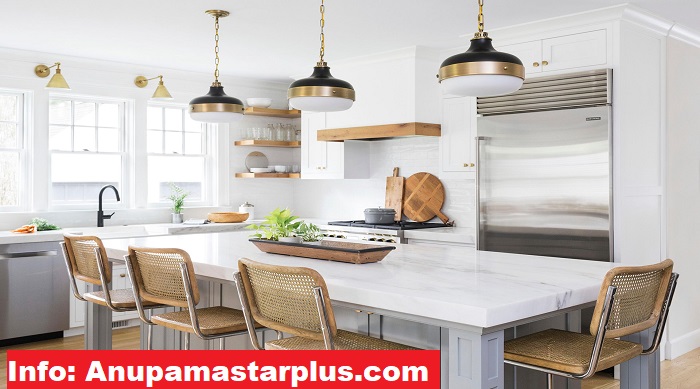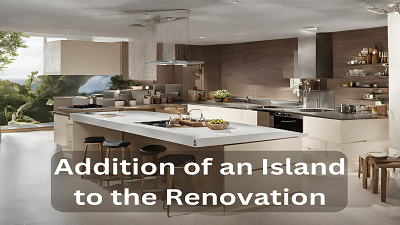Introduction: The Importance of Kitchen Islands
The kitchen is often considered the heart of the home, where families gather to cook, eat, and spend quality time together. In recent years, the kitchen island has become a staple feature in modern kitchens, serving both functional and aesthetic purposes. Whether you’re building a new kitchen or renovating an existing one, adding or upgrading your island can significantly enhance the overall look and feel of the space.
Assessing Your Kitchen Space
Before diving into the world of kitchen islands, it’s essential to assess your kitchen space to determine if an island is a feasible option. Consider factors such as the available square footage, traffic flow, and existing layout to determine the best placement for your island.
Types of Kitchen Islands
There are several types of kitchen islands to choose from, each offering unique benefits and features. Stationary islands are fixed in place and provide additional countertop and storage space. Portable islands, on the other hand, can be moved around the kitchen as needed, offering flexibility and versatility. For those looking for a custom solution, custom-built islands can be designed to meet specific needs and preferences.

Choosing the Right Material and Design
When it comes to kitchen islands, the material and design play a crucial role in both aesthetics and functionality. Popular materials for kitchen islands include wood, granite, quartz, stainless steel, and marble, each offering its own unique benefits in terms of durability, aesthetics, and maintenance requirements.
Functional Features to Consider
When designing your kitchen island, it’s essential to consider the functional features that will best suit your needs. This includes incorporating storage solutions such as cabinets, drawers, and shelves, as well as seating options such as bar stools or built-in seating. Additionally, you may want to consider adding extra appliances such as a sink, dishwasher, or wine cooler to enhance the functionality of your island.
Lighting Considerations
Proper lighting is essential for creating a functional and inviting kitchen space. When planning your island, consider incorporating task lighting to illuminate the workspace, ambient lighting to create a warm and inviting atmosphere, and decorative lighting to add a touch of style and flair.
Island Layout and Configuration
The layout and configuration of your kitchen island will depend on factors such as the size and shape of your kitchen, as well as your personal preferences and cooking habits. Single-tier islands are ideal for small kitchens with limited space, while multi-tier islands offer additional seating and storage options. Similarly, L-shaped and U-shaped islands can help maximize countertop space and create a more efficient workflow in larger kitchens.
Budgeting for Your Kitchen Island
Before embarking on a kitchen island project, it’s essential to establish a realistic budget based on your specific needs and preferences. Consider factors such as the cost of materials, labor, and additional features when determining your budget to ensure that you stay within your means.
Hiring a Professional vs. DIY Installation
When it comes to installing a kitchen island, you have the option of hiring a professional contractor or tackling the project yourself. While hiring a professional can ensure a seamless and professional installation, DIY installation can save you money and allow you to customize the island to your exact specifications. Consider the pros and cons of each option before making a decision.
Maintenance Tips for Kitchen Islands
To keep your kitchen island looking its best, it’s essential to implement a regular cleaning and maintenance routine. This includes wiping down the countertops and surfaces regularly, cleaning spills and stains promptly, and performing routine maintenance tasks such as oiling wooden surfaces or resealing stone countertops as needed.
Enhancing Aesthetics with Accessories
Once your kitchen island is in place, you can enhance its aesthetics and functionality with the addition of accessories such as bar stools, pendant lights, and decorative accents. Choose accessories that complement the style and design of your kitchen to create a cohesive and inviting space.
Case Studies: Real-Life Examples of Island Transformations
To inspire your own kitchen island project, consider exploring real-life examples of island transformations. From small updates to complete kitchen overhauls, there are endless possibilities for enhancing your kitchen with a stylish and functional island.

Conclusion: Transform Your Kitchen with a Stylish and Functional Island
Adding or upgrading your kitchen island is a surefire way to enhance the functionality, aesthetics, and overall value of your kitchen space. By carefully considering factors such as space, layout, materials, and design, you can create a customized island that meets your specific needs and preferences. Whether you’re looking to maximize countertop space, increase storage capacity, or simply create a gathering space for family and friends, a well-designed kitchen island is the perfect solution.



